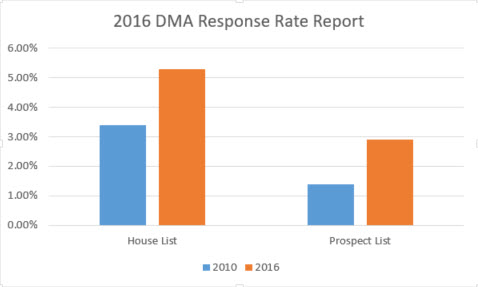
Direct mail healthcare marketing is alive and well.
Savvy healthcare marketers are increasingly turning to technology to help them gain the benefits of sending direct mailers, while taking advantage of the speed, scale and measurability of modern marketing techniques.
Direct mail was the original data driven marketing channel. Today, as email inboxes get more and more clogged, and digital marketing channels become more expensive, marketers are looking for proven ways to reach their audiences, while retaining the targeting, testing and analytics they’ve become accustomed to with their digital channels.
Table of contents
What is direct mail healthcare marketing?
Direct mail marketing is a type of marketing strategy of sending messages to your customers or patients using paper-based ad formats such as newsletters, flyers, brochures, catalogs, postcards, and sales letters.
Although digital marketing has grown tremendously in recent years, direct mail marketing for healthcare remains a prominent channel. This traditional strategy is still growing due to its proven impact on businesses.
Prominent healthcare providers know that direct mail advertising is one of the best and most profitable ways of reaching out to new and existing patients. For those in the pharmaceutical, medical-devices and healthcare technology industries, direct mail helps them reach physicians, administrators and other decision makers in healthcare organizations.
Modern direct mail for healthcare marketing involves software and automation

While the basics of printing and mailing promotions, advertisements and direct communications hasn’t changed, the way that healthcare marketers create and manage campaigns has.
Today, automated mailing services use cloud based software, CRM integration and open API’s to make direct mail look, act and feel like a digital marketing channel.
Marketers are able to login to software, build templates online, and send direct mailers out in minutes using data that is directly imported from their CRM or Marketing Automation tools. Then, automated system monitor the printing and delivery, as well as the response to individual mailers.
Multi-channel and triggered direct mail are exploding
Automated direct mail is as easy as sending email marketing campaigns. In fact, many healthcare marketers are using direct mail and email together. When combined with email, direct mail can be used to target email non openers to boost the response to multi-channel campaigns.
Have you ever thought you’d be able to send a single, targeted, highly personalized mailer out, just like you can with drip email campaigns? With the advent of triggered drip direct mail, you can create highly automated campaigns that process letters and postcards 24x7x365.
Why you need to consider using direct mail healthcare marketing

1. Consumers Trust Direct Mails the Most
In a survey conducted by MarketingSherpa, 76% of consumers trust print ads the most when deciding to purchase something.
Although digital media has made it easier and faster to acquire information, consumers don’t trust them due to many data privacy and security issues on the web
Even the digital-savvy millennials think print advertisements are more trustworthy than digital marketing materials.
Direct mails are also less intrusive. Readers won’t have to worry about someone who might be stealing their private information while reading the mails.
Healthcare providers are mandated to protect the privacy of their patient’s information. With direct mails, patients will be at ease since they are free from intruders, hackers, and leakage of their information online.
2. Direct Mails Target Audiences Better Than You Think
Direct mail marketing uses more data-driven demographic information to identify your target market and their specific needs.
With the targeted marketing strategy, healthcare organizations can reach their ideal clients or patients using their preferred database marketing and segmentation techniques.
You can use these four areas to identify your potential target markets:
- Demographic: Age, gender, occupation, and family situation (to know if they have children or elderly that needs specific medical attention such as vaccinations)
- Behavior: Needs, wants, and attitude in medical services
- Geographic: Where they live and the medical situation in their area
- Psychographic: Lifestyle (are they smokers or heavy drinkers?)
This allows medical providers to reach, create awareness in, and ultimately influence their desired group of people that would likely pursue the products and services that they are offering.
3. It Provides Personalized Communication With Customers
Personalized ads have a huge effect on how consumers perceive and interact with a brand. Customers like receiving mails with their names on them, and they feel extra special for personalized print ads and messages.
Direct marketing allows brands to deliver customized messages to their target audiences. You can market different products and services at once, without making it hard for your audience to understand your overall brand message.
4. ROI & Result Are Highly Trackable
Your marketing strategies should serve as an investment, rather than additional expenses. If your campaign strategy does not bring revenue, then it’s a waste of time and resources.
It may surprise you, but direct mail has a higher response rate than email, and the response rate has doubled since 2010!

The staying power of direct mails is still evident with its 5.1% response rate, while online ads, social media platforms, paid searches, and email campaigns only have a 1.8% response rate combined.
You can measure responses through the call to actions indicated in the mail.
Healthcare businesses can tell the readers to reach out to them via their company telephone numbers or visit their website.
You can also measure responses and ROI based on the sales you’ve made upon launching a direct mail campaign. For example, start a health screening campaign through direct mails and see how many patients will visit you within that period.
With these figures, one would not be surprised that 81% of marketers today plan to maintain or increase their direct mail usage in the next 12 months.
5. Good Marketing of Patient Experience
One way to convert readers into patients is to promote your patient experience. While online marketing remains the best platform for patient conversion, you can use both digital and print marketing to better promote patient experience.
The personalization of mail postcards produces better patient retention because of the extra effort and care that it shows. Thus, they will remember the great experiences of your patients and the quality services that you marketed through your direct mail.
Effective ways to use direct mail healthcare marketing

Direct mail healthcare marketing is an effective approach to cut through digital clutter and make your campaigns more memorable. Here are some ways on how to effectively use direct mails:
Create Walk-in Traffic
Creating walk-in traffic can be a key success metric of your direct mail healthcare marketing. Target people near your location and invite them to your office, clinic or hospital. You can create a great offer on the mailer and instruct them to bring it in for a discount on their first visit.
Whenever you have public health events such as seminars or free consultations, people near your area will most likely visit you, especially if they are well-informed about the event details.
Choose the Right Format
There are many types of direct mail for healthcare that you can use in your campaign. Here are the most popular ones:
- Letters (confidential and personalized messages)
- Postcards (clear, concise, and memorable ads)
- Self-mailers (cost-effective yet attractive mail marketing)
- Brochures (an aesthetically-pleasing way of giving existing and potential patients a glimpse of your services)
- Catalogs (detailed and organized listing of your healthcare services and contact information)
Customize Your Design and Copy
Consider using the right design, color, and copy when creating your direct mail healthcare marketing. Avoid cluttered and unnecessary information on every page to avoid loss of reading attention.
Pay attention also to every sensitive and private information that you will include in the mail.
As healthcare professionals, it is your primary responsibility to protect the information of your patients. Avoid sacrificing someone’s private information for the sake of your marketing.
Use Reviews and Testimonials
The majority of consumers today use online reviews when searching for a medical provider.
Encourage your patients to leave testimonials on your digital platforms and highlight the best ones in your direct mail healthcare marketing ads.
Use Data Targeting to Generate Leads and Conversions
Use a demographic-centered approach when customizing direct mails to your target audience. Knowing your target audience’s age, location, medical situation, and lifestyle would let you know who among them needs a specific campaign mail from you.
For example, if you have a campaign for breast cancer awareness, you can send out direct mails to women between ages 40-50 and encourage them to do their mammogram routine at your hospital. A strong and customized call to action will make them book an appointment with you.
Thank You and Voucher Cards
You may not know it, but a well-written thank you card goes a long way. It brings a more personal touch and longer-lasting impression on your patients.
Consumers also like tangible vouchers and discounts. So if you have promos on your healthcare services, it would be helpful to produce them through direct mails.
Integrate Direct Mail With Digital Marketing

Direct mail is only one of the many ways to market your brand. A great healthcare marketer should also take advantage of multiple marketing channels.
Successful brands would not depend only on social media ads and paid search campaigns. They will also use both direct mail and email marketing to communicate with their target audience, as well as SEO to boost their traffic.
The more platforms an individual can see you, the more chances of getting that person as a new patient or client.
“I was surprised to see your mail today! I recognized you immediately since I often see your ads on the Internet.”
When a patient can interact with you in multiple ways, their trust with your brand will eventually build up. The key here is to create a strong marketing strategy so potential patients can see and remember your message when they need it.
Drive your potential patients to reach you out through your telephone numbers or book an appointment on your website.
A targeted direct mail campaign can help you increase general awareness of your brand while driving them to learn more about you on different channels and, eventually, converting them into clients.
Consulting a digital marketing agency can also help you plan your campaigns effectively. Digitalis Medical and other healthcare marketing agencies can help you with your overall marketing plan to create better brand awareness and patient conversions.
Start Direct Mail Marketing in Your Practice Today!
With all the benefits of direct mail marketing to healthcare brands, it is no surprise that this strategy won’t be dead anytime soon. It complements your other branding efforts in a more beneficial way than you could imagine.
Analyze your current marketing efforts and see how they benefit your brand. Some campaigns may need better audience targeting and personalization, while others may need a direct mail marketing strategy to communicate with consumers more effectively.
Postalytics has automated direct mail marketing to help you bring better campaign results for a reasonable investment. Get started and expect more patients and revenue soon!
About the Author

Dennis Kelly
Dennis Kelly is CEO and co-founder of Postalytics, the leading direct mail automation platform for marketers to build, deploy and manage direct mail marketing campaigns. Postalytics is Dennis’ 6th startup. He has been involved in starting and growing early-stage technology ventures for over 30 years and has held senior management roles at a diverse set of large technology firms including Computer Associates, Palm Inc. and Achieve Healthcare Information Systems.
